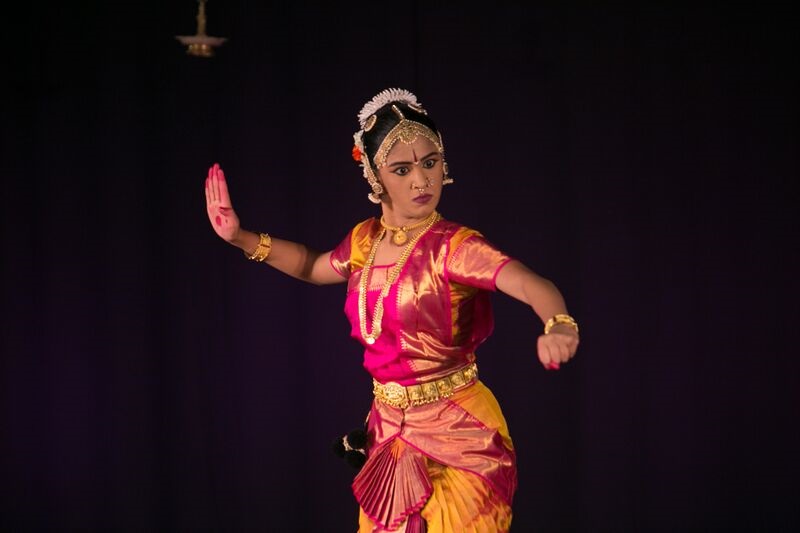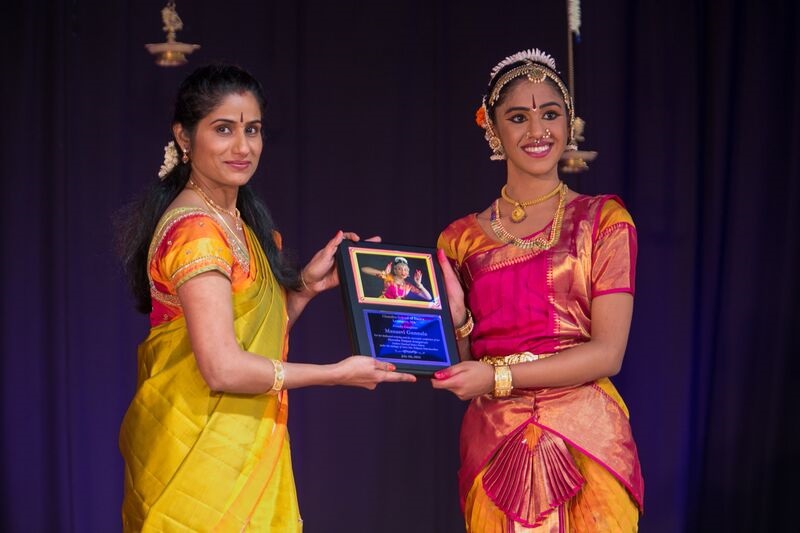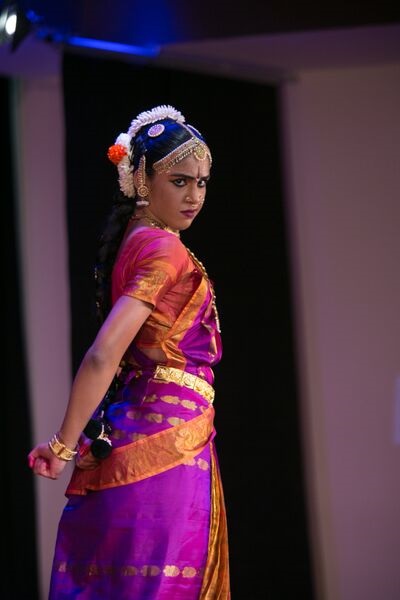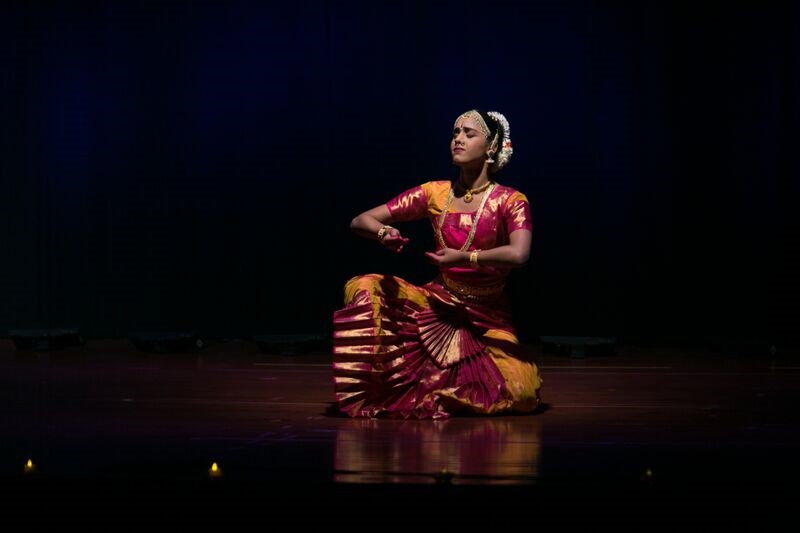Contribute
| Arangetram: Manasvi (Manu) Gunnala |
Sripriya Natarajan Moorthy
08/12/2015
An arangetram is a Bharatha Natyam dancer’s first opportunity to showcase her command over movement, expression and stamina—both physical and mental. An arangetram has even greater significance when the dancer is her guru’s first student to be presented on stage. Manasvi (Manu) Gunnala, disciple of Smt. Kalpana Balachundhar, director of Chandra School of Dance in Lexington, MA, did great credit to herself, her guru and her chosen art form in her debut solo performance on July 4, 2015 at the Chinmaya Mission Center, Andover, Massachusetts. Manu reflected her guru’s influence not only in her graceful, controlled movements and admirable expressions, but also in her dedication and humble devotion to a divine art form.
Manu, a rising sophomore at Lexington High School, made her stage entrance with a radiant smile and confident posture that would mark her entire debut program. In her first piece, a pushpanjali and sloka on Lord Ganapathi, in ragam Gowlai, set to Adi thalam, composed by Sri Madurai R. Muralidharan, Manu demonstrated her strong footwork, steady aramandi and balance, crisp mudras, precise eye movements and graceful body movements and alignments. Her fount of energy was evident in her immediate and tireless transition to a nimble alarippu in ragam Nattai, set to Rupaka thalam. With these first pieces, Manu set the expectation for a graceful, energetic, well-executed program. She did not disappoint. In her next piece, a fast-paced jathiswaram in ragam Vasantha, set to Rupaka thalam, Manu continued to showcase her strong nritta (pure dance) skills honed over seven years of training under Smt. Kalpana.
After a brief instrumental interlude of favorite light Carnatic tunes, Manu returned to capture her audience’s acclaim with an artistically choreographed and rendered varnam, “Manavi Chekona,†in ragam Sankarabarnam set to Adi thalam. In this varnam, the dancer expresses her desire to be with Lord Shiva. Manu beautifully evoked the emotion of shringaar (romantic love) through her facial expressions. I was especially taken by how she was able to portray shyness and attraction all with a glow of innocence that did not detract from the spiritual aspect of this varnam. Both sancharis (stories) were unique selections—one depicted how Lord Shiva came to be adorned with deer, snake, tiger skin and elephant hide, as He stopped a series of attacks conjured up by the irate rishis of Darukavana; the other depicted the five different arrows of Lord Kama (Cupid): the love-filled lotus, the speech-arresting asoka, the dizzying choka, the tear-inducing navamallika and the immobilizing nilothpala. Both sancharis were crafted as a brilliant combination of rhythmic footwork and myriad expressions. Manu balanced her proper form, strong expressions and maintenance of thalam throughout the pure instrumental accompaniment, demonstrating her strong command over each of the fundamentals of Bharatha Natyam. Her rapid and complete changes in body carriage allowed her to transform convincingly from pining girl to irate sage in seconds. Both pure dance and storytelling choreography were impressively original, but clearly rooted in classical precepts. Between Smt. Kalpana’s inventive direction and Manu’s heartfelt, radiant execution, the audience was captivated for the entire half-hour presentation of the varnam.
Manu returned after intermission to present a pair of dynamic keerthanams, one extolling the ten iconic avatars of Lord Vishnu, the other praising the cosmic dance of Lord Shiva. Manu brought poise and high energy to these pieces and demonstrated her balance through a variety of poses. She again drew upon her ability use her entire body and face to convey convincingly a wide range of emotions, vividly portraying the demon king Hiranyakashipu, the noble Rama, the valiant Kalki and many more characters in rapid succession in “Dasa Avataram (Paarkadal Alai Mele)â€, in ragam Shanmukhapriya, set to Adi thalam. She followed with a powerful, confident demonstration of Shiva’s thandavam in “Bho Shamboâ€, in ragam Revathi, set to Adi thalam. Manu’s energy was unabated as she concluded the traditional part of her program with one of Vidwan Madurai N. Krishnan’s Madura Thillanas, in praise of Sri Raja Rajeshwari (Goddess Parvathi), in ragam Hindolam, set to Adi thalam.
Bharatha Natyam has strong ties to the folk tradition, and Smt. Kalpana chose to highlight this important facet of the dance form by including a piece set to Sri Pambatti Siddhar’s quintessential snake dance melody, “Naagar Mudiâ€, in ragam Punnagavarali, set to Adi thalam. Manu stunned the audience with her flexible gymnastics as she bent backwards, swayed in rapid circles and walked on her hands as the holy snake. The program concluded with “Asato maa sadgamayaa,†a traditional prayer for enlightenment and peace, and the familiar Telegu mangalam “Ramachandrayaâ€. Manu’s joy and gratitude for a successful debut shone on her face just as clearly as it was conveyed during the eloquent and emotional votes of thanks and congratulations that marked the end of a delightful program.
The program was touched with class throughout, from the timely start to the thoughtfully selected repertoire—varied, thorough, but never dragging—to the excellent musical accompaniment. Smt. Kalpana’s debut nattuvangam was confident and clear. Smt. Bhuvana Ganesh brought out the emotion of each song with her finely tuned voice. Sri Gaurishankar Chandrasekhar’s masterful performance on mridhangam provided the rhythmic backbone essential for a vibrant dance presentation. Smt. Hema Balasubramanian expertly explored the nuances of each ragam on her evocative flute. Sri Surya Sundararajan deftly added a richness to each melody with his violin and bow. The surprise addition of veteran artist Sri S.V. Narayanan Iyer on the traditional morsing was the perfect finishing touch to a talented orchestra.
The love, respect and chemistry between guru and sishya was very beautiful and apparent throughout the program. Knowing both Kalpana and Manu personally through previous dance collaborations, I can attest that that their personalities are a perfect match. During the vote of thanks, Kalpana remarked movingly, “I have always thought of myself as a teacher and an ‘auntie.’ Today, Manu has promoted me to ‘guru.’†Manu’s skilled performance speaks to Smt. Kalpana’s depth of knowledge and dedication to impart this knowledge as a teacher. Her thoughtfully crafted choreography was a labor of love not only for a divine art form, but also for her first student. Smt. Kalpana’s efforts were matched by Manu’s dedication to acquire this art, apparent in the consistent quality of her footwork, body lines and expressions from start to finish. Her steadfast practice was clearly driven not only by respect for dance but also by her high esteem for her beloved guru. Throughout, the program had a sense of humility and devotion that elevated the debut from just a showcase performance to a celebration of Bharatha Natyam as a spiritual art, passed on from one generation to the next.
Like her guru, Manu is a soft-spoken, earnest and gentle person. I was astounded by the degree of confidence that this young, quiet girl exuded on stage—astounded, but delighted as she carried herself with the poise complementing her hard work and talent. Manu clearly intends her arangetram to be only the beginning of her journey in dance. Given the caliber of her debut performance, the strength of her character and the support of her guru, it will be a joy to see her blossom further, earning herself and the Chandra School of Dance more well-deserved successes.
You may also access this article through our web-site http://www.lokvani.com/



